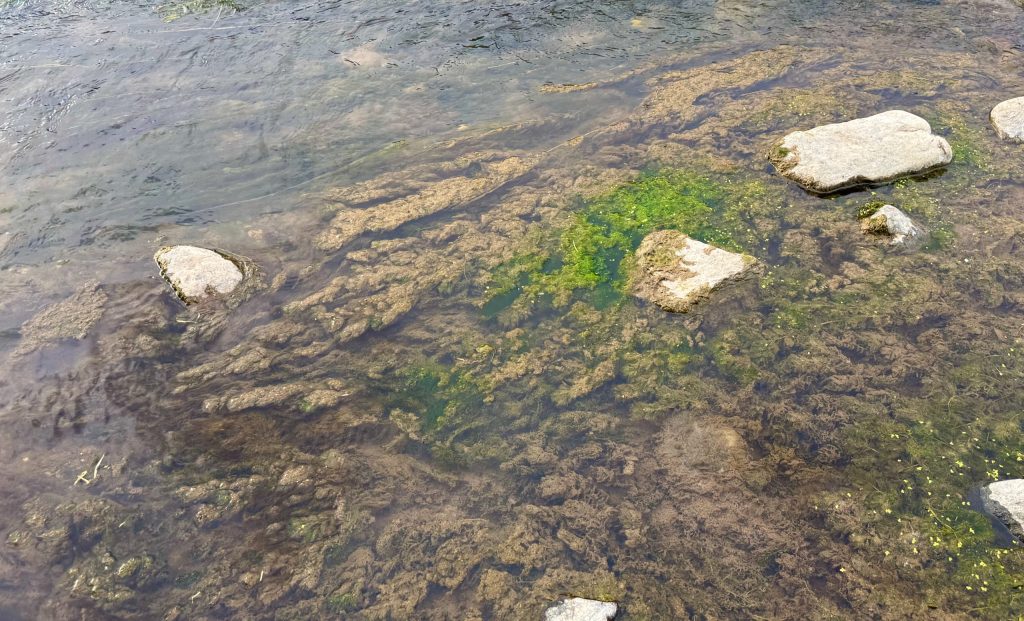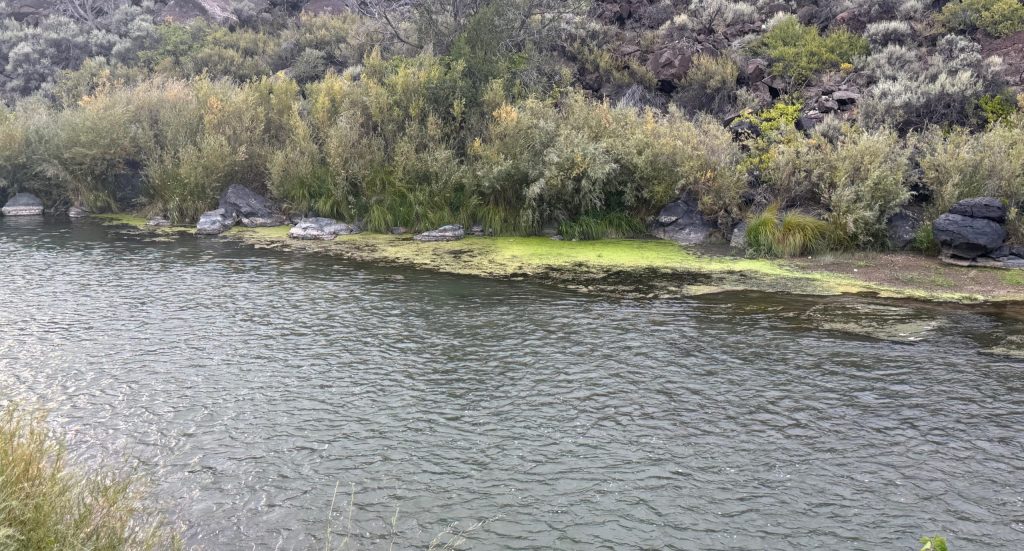Why is the Upper Rio Grande Green?
Visitors this past summer to the Río Grande del Norte National Monument observed that the river’s water, even upstream from its confluence with the Red River, appeared greenish. Why was that? As suggested in the above title, low river flows and high water temperatures, a result of climate warming as we described in a recent article, are part of the cause stimulating the greenish appearing algal growth in the river.
Fresh Water Algae
Some background first, freshwater algae have two main growth forms. Longer multi-celled strands of filamentous algae are most commonly found along shores and attached to rocks on the bottoms of slower flowing streams and rivers. Also, there are single celled algae, most species of which grow suspended in the water column. These are called phytoplankton.

Some of these single celled algae species also form small clumps of cells in the water column. In more extreme cases, clumps of some species can become obvious to the unaided eye; some can even appear looking like someone had dumped grass clippings into the water, as a public member once reported as having happen for a high mountain Montana reservoir where I was assessing its water quality.
Other forms of single cell algae also grow in clumps attached to rocks and other substrates, particularly along the stream bottoms. These are called periphyton and are a critical food source for larval insects, other invertebrates, and small fish, such as the endangered Rio Grande Silvery Minnow.
The taxonomic groupings of many algae classes are based on color. Green and blue-green algae being the two most common forms found in fresh waters.(Blue-green algae now are more technically and often called cyanobacteria, due to having internal cellular structures more like bacteria than algae, but they still produce energy through photosynthesis, like algae, and can fix elemental nitrogen into biologically useful compounds.) Strands of filamentous algae along shores and attached to the stream bottoms are most commonly green algae.
As the title above suggests, the greenish color of the river results from its low flow conditions and warm water temperatures, in part, with both tending to stimulate growth conditions for plankton that add their color to the water. Slow flowing or standing water is necessary for abundant planktonic algae to grow; higher flows with turbulence mixing tend to inhibit the growth of these algal forms.

Nutrients and Sources
The other likely cause of greenish appearing water and abundant plankton growth is commonly due to excess nutrients in the river. The nutrients of particular concern here are primarily nitrogen and phosphorus, which can occur in excess in the runoff from upstream agricultural fields and potentially from their residual concentrations in treated wastewater discharges and septic tank seepage to the river.
Of particular interest for the upper Rio Grande, drainage waters from volcanic geologies, prominent along the upper Rio Grande watershed, can include relatively high dissolved phosphorus concentrations. Such water chemistries can tend to favor growths of those blue-green algae species that can fix elemental nitrogen to stimulate their growth and population numbers. Without most detailed analysis of the river’s water chemistry, this can help to explain why the upper Rio Grande has appeared greenish, even blue-greenish this past summer.
Toxicity?
Here it is important to emphasize that not all types of blue-green algae produce toxins and those that can, do so mostly when water conditions are such for this to occur, which can include elevated water temperatures and nutrient chemistries. As such, this past summer the Bureau of Land Management was appropriate to issue caution regarding the potential for toxicants accompanying the their reports of blue-green blooms in the upper Rio Grande. Fortunately, it appears that no adverse toxic effects to individuals or pets seem to have occurred. That caution likely should continue into the future summers as recurring cyanobacteria blooms are likely to occur as climate warming continues and perhaps intensifies.
Additional Information
Bureau of Land Management. 2025. BLM field office notifies public about algae blooms in the Rio Grande. https://www.blm.gov/announcement/blm-field-office-notifies-public-about-algae-blooms-rio-grande
Centers for Disease Control and Prevention. 2024. How People and Animals Get Sick From Harmful Algal Blooms. https://www.cdc.gov/harmful-algal-blooms/causes/index.html
NMPBS. 2019, Our Land: New Mexico’s Environment Past, Present, and Future–Toxic Blue-Green Algae Blooms in New Mexico Lakes. https://www.pbs.org/video/toxic-blue-green-algae-blooms-in-new-mexico-lakes-7hwkl2/
Marcus, M. 2025. New Mexico Drought, Aridification & Desertification. https://nmwateradvocates.org/new-mexicos-water-crisis-drought-aridification-desertification/
Taos News. 2025. BLM investigates algae blooms in Rio Grande. https://www.taosnews.com/news/environment/blm-investigates-algae-blooms-in-rio-grande/article_d28ad8fb-676a-5d45-b875-96bc69e34702.html

